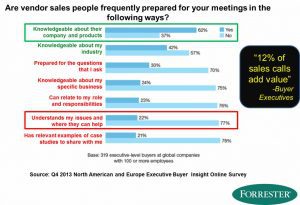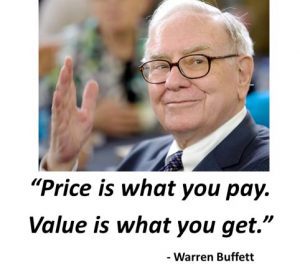How useful is your marketing content? Does it support effective customer conversations? Does it help sales increase the number of qualified opportunities?
On average, buyer executives are rarely impressed by the content that sales uses. A Forrester  buyer survey found that 62% of sales people are knowledgeable about their own company and products, but that 77% don’t understand buyer issues and how they can help. According to these buyer executives, only 12% of sales calls add value. Despite the $161 billion of B2B marketing spending per year in the US, most of the content produced does not support sales effectiveness. Most sales people lack the materials and/or the skills to provide convincing answers to the question “what do you do for your customers?”
buyer survey found that 62% of sales people are knowledgeable about their own company and products, but that 77% don’t understand buyer issues and how they can help. According to these buyer executives, only 12% of sales calls add value. Despite the $161 billion of B2B marketing spending per year in the US, most of the content produced does not support sales effectiveness. Most sales people lack the materials and/or the skills to provide convincing answers to the question “what do you do for your customers?”
Content Quality. Sales organizations are increasingly implementing sales enablement software to make it more efficient for reps to find the most suitable materials for customer interactions. But these software solutions are only as helpful as the quality of the uploaded  content. As you look through your collateral, which single piece of marketing content is most likely to support sales in a conversation about what you do for your customers?
content. As you look through your collateral, which single piece of marketing content is most likely to support sales in a conversation about what you do for your customers?
Company presentations rarely achieve this objective. Pricing sheets emphasize what your product or solution costs the buyer, not the value that they get. Website content and videos frequently miss the mark. Product brochures and presentations usually describe product features better than they describe customer benefits. Even when product content provides information about customer benefits, it is often buried in the brochure or presentation and is rarely quantitative. The result is that most content does not touch on or sustain conversations about what you do for your customer. Sales reps need substantive marketing collateral that supports a convincing case that the customer should engage in further sales discussions and evaluate your solution. For many sales reps, the elevator pitch is missing the fundamentals of why the customer should buy, because sales lacks the content to support the conversation.
Case Studies. But one type of marketing content is different. Case studies, by their very nature, answer the question “what do you do for your customer?” Case studies are especially  relevant if the customer studied is similar to the prospect, but case studies are broadly useful because they are inherently customer-centric. Case studies, whether naming a specific customer or preserving a customer’s anonymity, provide concrete information about what you did for another customer and the benefits your product or solution provided to that customer. The best case studies highlight how your product is better, how much better you are and what that means economically for your customer.
relevant if the customer studied is similar to the prospect, but case studies are broadly useful because they are inherently customer-centric. Case studies, whether naming a specific customer or preserving a customer’s anonymity, provide concrete information about what you did for another customer and the benefits your product or solution provided to that customer. The best case studies highlight how your product is better, how much better you are and what that means economically for your customer.
As a matter of practice, how are most case studies used by sales? Strangely enough, they are  rarely used in conversations. Instead, case study pdfs are most often emailed to prospects as meeting follow-ups or as part of a nurturing campaign, rarely serving as a focal point for a sales conversation.
rarely used in conversations. Instead, case study pdfs are most often emailed to prospects as meeting follow-ups or as part of a nurturing campaign, rarely serving as a focal point for a sales conversation.
The opportunity missed is significant. Case studies can provide a way to have a customer conversation not just about what you have delivered, but also about what problems you solve and how you solve them. This helps connect with a prospect, but it also helps to get the prospect talking about their problems and their challenges. This creates the opportunity to explore whether the prospect’s problems and challenges are problems that your product or your solution addresses. If you don’t address a prospect’s problems, it may be time to call on someone else. Case studies help to qualify. Concentrating sales team time and energy on qualified accounts is the key to increasing the number of closed opportunities.
Are Your Current Case Studies Useful in Sales? Why don’t case studies get used in more customer conversations? Some case study pdfs contain too much information, but the more general problem is that case studies usually aren’t very flexible. Too often, they are provided to sales as a static historical narrative. This format doesn’t support sales in turning a conversation about what you did for another customer into a conversation about what you can do for the prospect you have on the call or in the meeting.
In practice, the typical case study delivered by marketing to a customer’s already crowded inbox rarely fulfills its potential as a sales tool. The content of a case study should be an ideal way both for sales to highlight the connection between your solution and your customer in a conversation and to ask the right questions.
Case studies should be useful as a prompt to customer questions like:
- “Is this a problem for you?” or
- “Have you considered ways to address this problem?”

More specific case-study-generated questions can get the customer thinking and speaking more directly about the magnitude of their problem while simultaneously advancing the sales discovery process. Examples include:
- “do you have an estimate what you spend on energy at this facility?”
- “how many design engineers do you have?” or
- “how do these sales metrics compare with your average deal size?” “…with your average sales cycle?” “…with your average conversion rates?”
There are also more directed questions that sales can ask to push the buying process forward while identifying customer decision criteria:
- “would reducing tech time by 20% move the needle for your hospital?”
- “would ROI of 130% meet your finance team’s hurdle rates?” or
- “would a payback of ten months be something you would consider in this fiscal year?”
Finally, starting with a story about how another customer achieved the benefits of your solution, there are natural questions that can help get the right next meeting:
- “how do you manage this process in your organization?” or
- “who would be involved in this sort of implementation here?”
Answers to these questions can help a rep move the ball down the field. They can also help a rep spend time on more qualified leads.
 When answers to these questions start to come out in a conversation, the standard case study design is flawed. It can’t be modified to incorporate information about the prospect. It can’t be used to adapt the argument to the prospect’s business specifics. It doesn’t support moving the conversation toward a more representative number for what your solution might be worth to this specific prospect. The typical, static case study doesn’t allow a rep to steer the focus of a conversation to the benefits that matter to a customer stakeholder, or to weed out benefits that don’t resonate with a prospect. The rep lacks a good tool to adapt the conversation. As a result, the case study story is rarely told. Valuable questions are rarely asked early enough in the sales cycle.
When answers to these questions start to come out in a conversation, the standard case study design is flawed. It can’t be modified to incorporate information about the prospect. It can’t be used to adapt the argument to the prospect’s business specifics. It doesn’t support moving the conversation toward a more representative number for what your solution might be worth to this specific prospect. The typical, static case study doesn’t allow a rep to steer the focus of a conversation to the benefits that matter to a customer stakeholder, or to weed out benefits that don’t resonate with a prospect. The rep lacks a good tool to adapt the conversation. As a result, the case study story is rarely told. Valuable questions are rarely asked early enough in the sales cycle.
Flexible Case Studies. But it isn’t hard to make a case study more flexible. Good case studies identify quantified benefits. Connecting the magnitude of case study benefits to a few key business assumptions is usually simple math. Making key assumptions accessible is straightforward design. Making it possible to turn off irrelevant sources of value can help focus the conversation and/or decide that the account isn’t qualified. If assumptions are accessible and changeable and if answers are recalculated, the case study can be gradually transformed into a more specific Value Proposition for the prospect that can ultimately turn into a business case to buy that is shared with the customer.
A flexible case study is a more effective and subtle way both to get early customer  collaboration and to build customer trust as prospects provide information about their business and their problems. It is a way to avoid those awkward moments when a perceived barrage of discovery questions shuts down a customer conversation because the prospect doesn’t have the time or won’t take the risk of providing substantive or sensitive information.
collaboration and to build customer trust as prospects provide information about their business and their problems. It is a way to avoid those awkward moments when a perceived barrage of discovery questions shuts down a customer conversation because the prospect doesn’t have the time or won’t take the risk of providing substantive or sensitive information.
Case studies are useful early in the sales cycle with typical (not specific) customer data. Good case studies invite a sales rep to tell a story. A flexible case study can be an engaging, natural way for a sales rep to help a customer understand quickly and persuasively how your solution is better and how that benefits the customer.
When prospects identify with a relevant case study, they see the connection between their problems and your solution. When prospects engage in a case study conversation about how your solution created value for another customer, their confidence in your ability to deliver for them increases. When prospects indicate that a problem solved for another customer applies to them, it helps a sales rep to qualify the account and steer the conversation toward topics that matter specifically to the prospect. If the case study problems that your solution solves don’t apply to or resonate with a prospect, that is a good reason for the sales rep to spend less time on the account.
Designing Value Propositions as Flexible Case Studies. CRM data from organizations adopting value selling show that opportunities where a Value Proposition is used (1) have 5-15% higher win rates and (2) 5-25% higher price outcomes. There is good reason to make the investment of time and bandwidth in designing good Value Propositions. Value Propositions are a tool for use by sales teams in call preparation, customer conversations and presentations to customer teams. They can be designed with users in mind where increasingly customer-facing teams include both sales representatives and presales professionals.
A great Value Proposition has the flexibility to transition gradually and continuously through the sales cycle. Starting as a Flexible Case Study, a Value Proposition is a tool that can be used  with typical customer data in early sales conversations. Gradually customer specifics are revealed and unfold through customer interaction and become embedded in the Value Proposition as it provides a basis for Customer Value Analysis and presales customization as customers evaluate your solution. As customers decide to purchase, the Value Proposition becomes a Shared Business Case, collaboratively agreed between sales executives and customer sponsors, that can be used by buyers as their own internal financial justification to purchase.
with typical customer data in early sales conversations. Gradually customer specifics are revealed and unfold through customer interaction and become embedded in the Value Proposition as it provides a basis for Customer Value Analysis and presales customization as customers evaluate your solution. As customers decide to purchase, the Value Proposition becomes a Shared Business Case, collaboratively agreed between sales executives and customer sponsors, that can be used by buyers as their own internal financial justification to purchase.
Increasingly, the best B2B teams use Value Propositions collaboratively to improve B2B sales team performance, addressing sales challenges throughout the B2B sales cycle. For account executives and sales reps, they are useful early in the sales cycle as Flexible Case Studies in call  preparation, in building sales confidence, in qualifying opportunities and in engaging customer executives. For technical sales and presales professionals, joining a customer-facing team in the middle of the sales process, Value Propositions provide Customer Value Analysis as an important way to address presales challenges and to maximize the impact of presales. Sales and presales teams, working together, use Value Propositions to highlight differentiation and cut through complexity as they collaborate with customer stakeholders to build a shared business case to buy. That Shared Business Case can be used to accelerate the closing process.
preparation, in building sales confidence, in qualifying opportunities and in engaging customer executives. For technical sales and presales professionals, joining a customer-facing team in the middle of the sales process, Value Propositions provide Customer Value Analysis as an important way to address presales challenges and to maximize the impact of presales. Sales and presales teams, working together, use Value Propositions to highlight differentiation and cut through complexity as they collaborate with customer stakeholders to build a shared business case to buy. That Shared Business Case can be used to accelerate the closing process.
Value Propositions that function as Flexible Case Studies are a huge improvement on value calculators. Value Propositions are about more than getting the math right. They provide central content that helps sales teams communicate what your solution does for your customers. Value Propositions are a shared basis for sales collaboration that help sales teams win.

